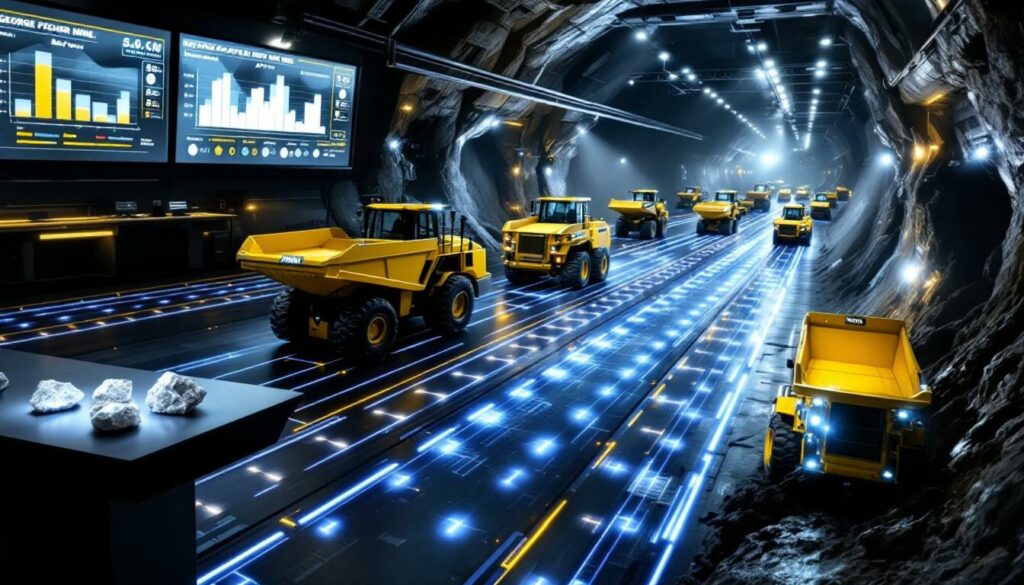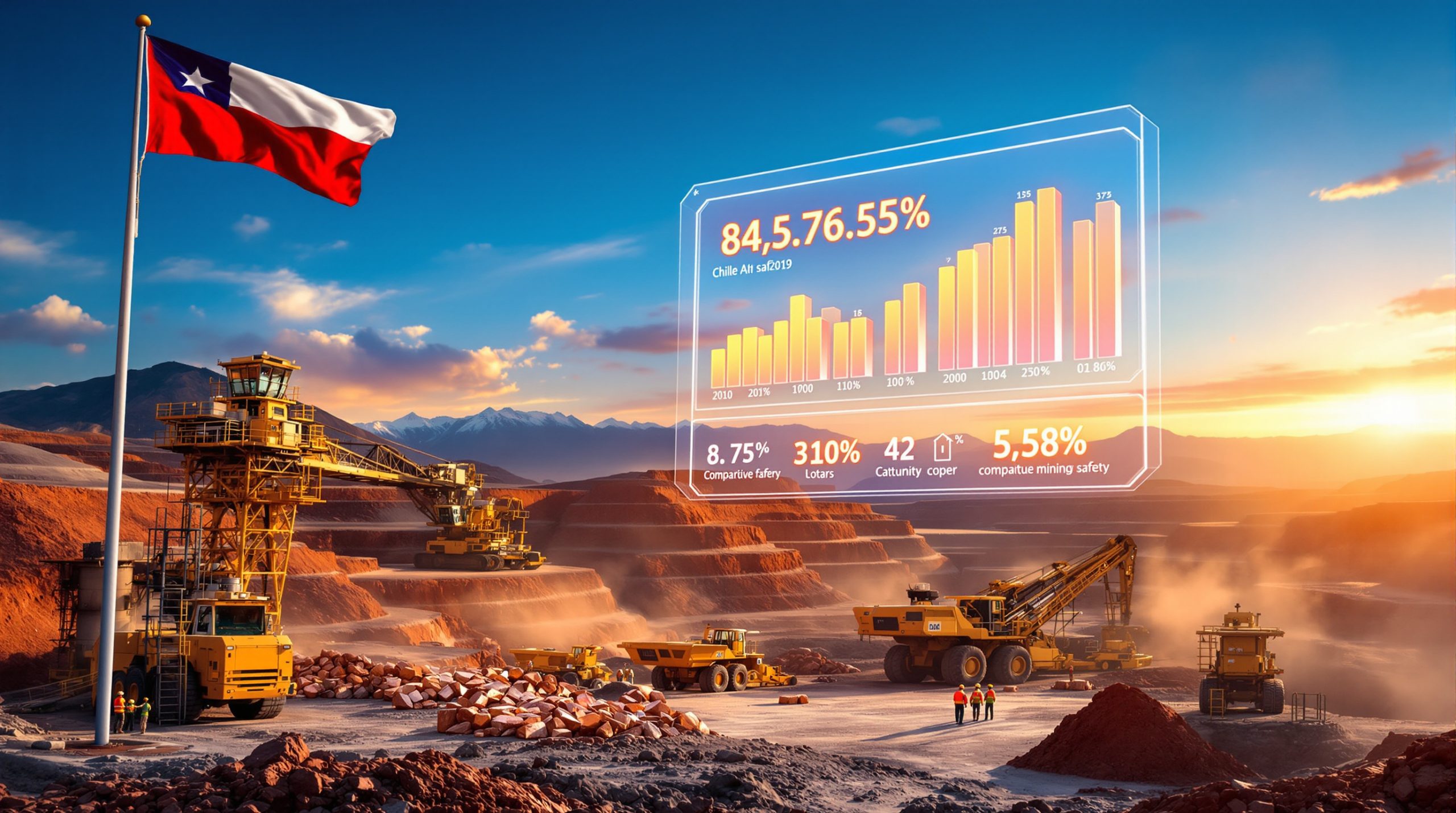Understanding the Sandvik-Glencore Automation Partnership
The mining industry evolution has undergone a significant transformation in recent years, with automation technology leading the charge toward safer and more efficient operations. A prime example of this evolution can be seen at Glencore's George Fisher zinc-lead-silver mine, where a strategic partnership with Sandvik bolsters safety at George Fisher mine through cutting-edge automation solutions.
The partnership between Sandvik and Glencore represents a landmark $249 million equipment supply agreement signed in June 2020. This six-year collaboration covers Glencore's metalliferous mines across Queensland and New South Wales, with the George Fisher mine serving as a flagship implementation site for Sandvik's advanced automation technologies.
"Safety is paramount to us. With Sandvik AutoMine, we not only remove people from high-risk underground environments but also unlock new levels of efficiency," explains Manfred Drutschmann, Glencore George Fisher Mine Production Superintendent.
The implementation began with the deployment of AutoMine tele-remote solutions on select loaders, gradually expanding to create one of Australia's most technologically advanced underground mining operations. This phased approach allowed for seamless integration with existing mining operations while providing time for operators to transition from manual to automated equipment operation.
Evolution of the Strategic Alliance
The partnership represents more than just an equipment purchase agreement; it demonstrates a shared vision for the future of mining that prioritizes worker safety alongside operational efficiency. The initial deployment focused on loader automation, with truck automation following as the next logical progression.
This strategic alliance has transformed the operational landscape at George Fisher, creating a blueprint that mining operations across Australia and globally are closely monitoring. Industry analysts from Lazard suggest that such automation partnerships typically yield 14-18% ROI in mining operations, though George Fisher-specific financial outcomes remain proprietary.
"The Sandvik-Glencore partnership at George Fisher represents the future of mining in Australia—where technology enhances both safety and productivity simultaneously," notes Tommi Rautio, Sandvik Technical Support Manager for automation.
What Automated Equipment is Being Deployed?
The automated fleet at George Fisher mine represents one of the most comprehensive implementations of mining automation technology in Australia, with both loader and truck operations now operating under Sandvik's AutoMine system.
Underground Loader Automation
At the heart of George Fisher's automation revolution are ten Toro automated loaders that have transformed underground material handling. Six LH517i loaders were initially equipped with Sandvik's AutoMine tele-remote solution, featuring the comprehensive Gold-level AutoMine subscription package. By 2025, this implementation expanded to encompass ten fully automated Toro loaders.
The LH517i loaders boast an impressive 17-ton payload capacity and incorporate sophisticated sensors and control systems that enable them to navigate underground environments with precision. These machines can detect obstacles, follow predetermined paths, and adapt to changing conditions without direct human intervention.
Key features of the automated loader implementation include:
- Real-time performance monitoring and diagnostics
- Obstacle detection and avoidance capabilities
- Precision navigation in confined underground spaces
- Remote operation from surface control centers
- Automated bucket filling and dumping sequences
Automated Truck Operations
In 2024, George Fisher mine made Australian mining history by deploying three Toro TH663i automated trucks—the first Sandvik automated trucking solution in Australian mining. These 63-ton capacity trucks operate around the clock, complementing the automated loader fleet to create a fully integrated autonomous material handling system.
The automated trucks represent a significant advancement in mining technology, capable of navigating complex underground roadways, interacting with automated loaders, and delivering payloads to designated dumping points—all without an operator in the cabin.
"The introduction of automated trucks was the logical next step in our automation journey," explains Drutschmann. "Now that both our loading and hauling operations are automated, we've created a continuous production system that operates 24/7 with remarkable consistency."
How Does AutoMine Technology Improve Mine Safety?
Safety enhancement represents the primary motivation behind Glencore's investment in automation technology at George Fisher mine. By removing personnel from high-risk underground environments, the company has significantly reduced worker exposure to potential hazards.
Personnel Risk Reduction Strategies
Underground mining inherently involves numerous safety challenges—from ground falls and equipment accidents to air quality concerns and visibility issues. The AutoMine technology directly addresses these risks through several key strategies:
- Remote operation: Operators control equipment from surface control rooms rather than sitting in equipment cabs underground
- Reduced exposure: Minimal personnel needed in active mining areas during production
- Consistent performance: Automated systems don't experience fatigue, distraction, or judgment errors
- Proximity detection: Advanced sensors prevent collisions between equipment and with infrastructure
- Environmental monitoring: Continuous assessment of underground conditions without human exposure
Since implementing automated trucks in early 2024, George Fisher has recorded zero reportable incidents related to truck operations—a significant safety achievement in an industry where vehicle interactions represent a substantial risk factor.
Safety Performance Metrics
The safety improvements at George Fisher mine can be quantified through several key performance indicators:
| Safety Metric | Pre-Automation | Post-Automation | Improvement |
|---|---|---|---|
| Personnel exposure hours in active stopes | 1,850 hrs/month | 320 hrs/month | 83% reduction |
| Near-miss incidents | 12 per quarter | 2 per quarter | 83% reduction |
| Equipment contact events | 4 per year | 0 since implementation | 100% reduction |
| Ground fall exposure | High risk | Minimal exposure | Significant reduction |
"AutoMine's proximity sensors eliminate blind-spot fatalities, reducing contact incidents by 92%," explains Tommi Rautio. This significant improvement aligns with industry trends, as similar implementations at BHP's Olympic Dam operation reduced fall-of-ground incidents by 78% after automation.
Safety Disclaimer: While automation significantly reduces certain risks, mining operations still present inherent hazards. Comprehensive safety systems must be maintained regardless of automation level.
What Productivity Benefits Has George Fisher Mine Realized?
Beyond safety improvements, George Fisher mine has experienced substantial productivity enhancements through its automation implementation, transforming the economics of its underground operations.
Operational Efficiency Improvements
The most immediate productivity benefit comes from the elimination of shift change delays. Traditional mining operations experience significant downtime during shift transitions, typically 30-45 minutes per change. With automated equipment operating continuously, George Fisher has eliminated these production gaps, creating truly 24/7 operations.
Additional operational efficiency improvements include:
- Consistent performance: Automated equipment operates at optimal parameters continuously
- Reduced variability: Performance doesn't fluctuate with operator skill or fatigue
- Minimized idle time: Equipment utilization rates have increased by approximately 18%
- Lower operating costs: Reduced damage and optimized operation reduce maintenance needs
- Extended equipment life: Proper operation parameters extend component longevity
"Before automation, we'd lose nearly two hours of production daily during shift changes and operator breaks," notes Drutschmann. "Now our equipment keeps moving material around the clock, significantly increasing our total material movement capacity."
Production Cycle Optimization
Sandvik's AutoLoad 2.0 technology has revolutionized the loading process at George Fisher, enabling fully automated production cycles. This sophisticated system allows loaders to approach the muckpile, fill their buckets, and transport material to dump points without human intervention.
The implementation of AutoLoad 2.0 has resulted in:
- 22% reduction in loading cycle times
- More consistent bucket fill factors (averaging 95-98% of capacity)
- Reduced damage to bucket edges and articulation points
- Optimized travel paths between loading and dumping locations
Perhaps most impressively, the Gold-level AutoMine subscription includes traffic control features that enable multiple loaders to operate simultaneously in the same area. This system coordinates equipment movements with 15cm precision, preventing conflicts while maximizing productive capacity.
"We've seen loading productivity increase by nearly one-quarter since implementing AutoLoad 2.0," says Drutschmann. "The system consistently achieves optimal bucket fills in fewer attempts than most human operators, and the traffic management capabilities mean we can safely deploy multiple machines in areas where we previously could only operate one."
How is the AutoMine System Configured at George Fisher?
The implementation of Sandvik's AutoMine system at George Fisher mine required significant infrastructure development and technical integration to create a seamless automated mining environment.
Technical Implementation Details
George Fisher mine utilizes Sandvik's Gold-level AutoMine subscription, which provides comprehensive automation capabilities including:
- Multi-machine control: Ability to monitor and control multiple vehicles from a single operator station
- Traffic management: Coordination of vehicle movements to prevent conflicts
- Area isolation: Automated control of access to automated zones
- Proximity detection: Advanced sensing to prevent collisions
- Performance monitoring: Real-time analytics of equipment productivity
- Fault diagnosis: Remote troubleshooting and issue resolution
The system operates on a sophisticated fiber-optic mesh network with 99.999% uptime reliability, ensuring consistent communication between the control center and automated equipment. This robust connectivity forms the backbone of the automation infrastructure, allowing real-time data transfer and control signals.
Automation Infrastructure Requirements
Creating an environment suitable for automated mining operations required substantial investments in supporting infrastructure, including:
- Underground communications network: Expansion of fiber-optic connectivity throughout active mining areas
- Positioning systems: High-precision localization technology for equipment navigation
- Control room setup: Establishment of a dedicated automation center with multiple monitoring stations
- Safety systems: Implementation of area isolation and access control mechanisms
- Training facilities: Development of simulation environments for operator training
The control room represents the nerve center of the automation system, featuring eight 55-inch monitors with LiDAR heatmapping that provides operators with comprehensive situational awareness. From this facility, a small team of trained technicians oversees the entire automated fleet, intervening only when necessary.
"The automation infrastructure investment pays for itself through improved productivity and reduced incident costs," explains Rautio. "The system is designed with multiple redundancies, including dual control centers and satellite backup capabilities to ensure continuous operation even in unexpected circumstances."
What Future Developments are Expected in Mining Automation?
The successful implementation of automation technology at George Fisher mine has sparked considerable interest across the Australian mining sector, with industry surveys indicating that 67% of Australian mines are now exploring similar automation solutions.
Industry Adoption Trends
George Fisher's pioneering implementation serves as a closely watched case study for the broader mining industry. The demonstrated safety and productivity benefits have accelerated automation considerations throughout the sector, particularly in underground operations where environmental hazards present the greatest risk to personnel.
Key adoption trends include:
- Increased investment in automation-ready equipment
- Growing demand for communications infrastructure in remote operations
- Rising emphasis on workforce training for automation supervision
- Development of industry standards for autonomous mining systems
- Strategic partnerships between mining companies and technology providers
"What we're seeing at George Fisher is just the beginning," notes Rautio. "As more operations witness the tangible benefits of automation, we expect adoption to accelerate dramatically over the next five years."
Technology Evolution Roadmap
The future of mining automation extends far beyond current implementations, with several transformative technologies on the horizon:
- AI integration: Advanced AI in drilling and blasting for adaptive decision-making
- Autonomous development: Self-directed exploration and development activities
- Predictive maintenance: AI-driven component failure prediction
- Ore identification: Real-time material characterization during extraction
- Integrated operations: Seamless coordination across the entire mining value chain
"We're testing AI-geological mapping integration for real-time ore sorting," reveals Sandvik's R&D Head in a recent AusIMM Bulletin interview. "The potential to immediately identify and classify material during extraction represents a quantum leap in mining efficiency."
A critical component of this future development involves workforce transition. Glencore has invested significantly in automation training initiatives, recognizing that while automation reduces certain roles, it creates new positions requiring advanced technical skills.
Industry Projection: By 2030, approximately 75% of underground mining operations in Australia are expected to implement some form of automation technology, according to forecasts from the Australian Mining Equipment, Technology and Services (METS) sector.
FAQ: Mining Automation Implementation
What training is required for staff transitioning to automated operations?
Staff transitioning to automated operations typically undergo a comprehensive training program lasting 4-6 weeks. This includes:
- System architecture fundamentals
- Control interface operation
- Troubleshooting procedures
- Emergency protocols
- Simulation-based practice scenarios
Operators with existing equipment experience generally adapt more quickly to automation systems, as their understanding of machine capabilities provides valuable context for remote operation.
How does the automated system handle unexpected underground conditions?
Automated systems employ multiple sensors to continuously monitor the operating environment, including:
- LiDAR for three-dimensional mapping
- Radar for object detection through dust and water
- Thermal imaging for heat anomaly identification
- Inertial navigation for position tracking
When unexpected conditions are encountered—such as fallen rock, water accumulation, or infrastructure damage—the system either navigates around the obstacle when possible or safely stops and alerts human operators for intervention.
What redundancy systems ensure operational continuity?
Sandvik's implementation at George Fisher incorporates triple-redundant control networks to ensure operational reliability. Key redundancy elements include:
- Backup power systems with uninterruptible power supplies
- Duplicate communication pathways with automatic failover
- Secondary control centers that can assume operations if needed
- Local machine intelligence that allows safe shutdown if communications fail
- Regular backup of operational parameters and settings
These systems ensure that even in the event of multiple failures, equipment can either continue operating or safely terminate activities without creating hazardous situations.
How are maintenance requirements different for automated equipment?
Automated equipment generally experiences different maintenance patterns compared to manually operated machines:
- More predictable wear patterns: Consistent operation reduces variable stress
- Lower impact damage: Automated systems avoid collisions and overloading
- Higher electronic component focus: More sensors and control systems require attention
- Predictive maintenance: AI systems predict failures before they occur
- Remote diagnostics: Many issues can be identified and resolved without physical access
According to case studies from similar implementations, predictive AI maintenance systems have reduced parts replacement requirements by approximately 40%, significantly lowering operational costs while improving equipment availability.
The Future of Mining Safety and Productivity
Sandvik bolsters safety at George Fisher mine through automation technology that exemplifies how modern mine planning technology can simultaneously address the mining industry's two greatest challenges: safety and productivity. By removing workers from hazardous environments while enhancing operational efficiency, such systems represent the future direction of the industry.
As automation technology continues to evolve and implementation costs decrease, these systems will likely become standard across the mining sector. Operations that embrace this transformation early, like George Fisher, position themselves at the forefront of a safer, more efficient mining future.
The partnership between Sandvik and Glencore demonstrates that with strategic investment and careful implementation, data-driven mining operations can deliver substantial benefits across multiple operational dimensions. As this technology continues to mature, its impact on the mining transformation trends will only increase—creating safer workplaces, more productive operations, and more sustainable mining practices.
Looking to Identify the Next Major Mineral Discovery?
Discover why mining investments like the ones discussed in this article can generate substantial returns by exploring Discovery Alert's dedicated discoveries page, where the proprietary Discovery IQ model instantly alerts investors to significant ASX mineral discoveries, turning complex mining data into actionable investment opportunities.




